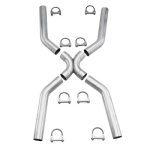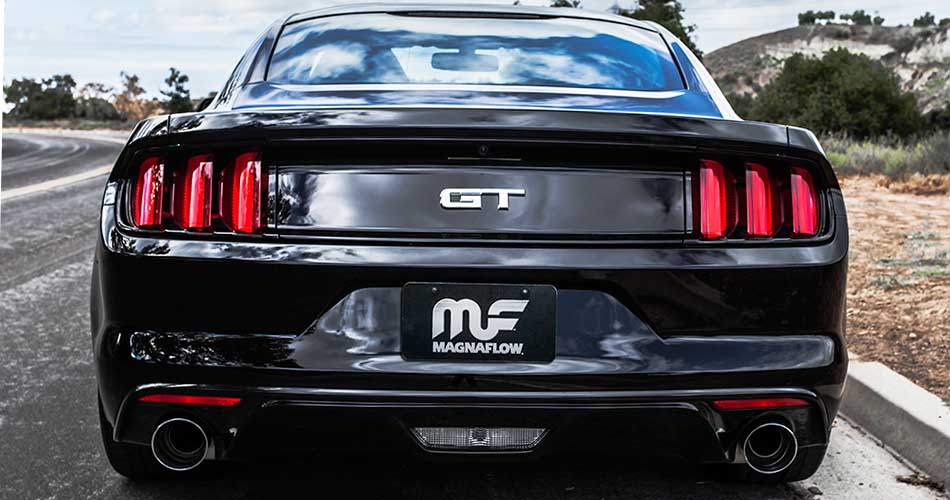Let’s break down the anatomy of an exhaust system—each component, what it does, and why it matters.
Remember the first time you talked anatomy in the classroom? Yeah—well, this discussion of anatomy probably isn’t going to be nearly as eye-opening, exhilarating, frightening, or embarrassing (or all of the above) as that conversation. But for aspiring hot rodders, the “exhaust talk” is just as important.
We couldn’t find a creepy old gym teacher to teach our exhaust anatomy lesson, but hopefully we’ll do a better job anyway.
Why Choose Aftermarket Exhaust Components?
The factory exhaust system on your vehicle is designed to muffle sound as much as possible. This also means it restricts the flow of exhaust gases out of your engine, creating what’s called backpressure. While most engines require some backpressure to operate properly, it also robs power. Essentially, the engine has to use some of the power it generates to cram exhaust gases out of the tailpipe instead of using that power to drive the vehicle.
If you’d like to steal some of that power back, you can replace that stock exhaust with less-restrictive performance exhaust components. In some upcoming posts, we’ll show you how to choose the right components—exhaust kits, headers, mufflers, etc.—for your vehicle. But let’s start with a quick review of exhaust systems and components and some of the upgrade options that are available.
 Headers/Exhaust Manifolds
Headers/Exhaust Manifolds
The first exhaust components to handle spent exhaust gases from your engine, headers (also called exhaust manifolds in stock form) are bolted to the cylinder heads and scavenge exhaust gases from the combustion chambers.
Aftermarket headers are typically mandrel-bent to reduce exhaust restriction, allowing the exhaust gas to move freely from the engine. This reduces power-robbing backpressure and helps build up enough exhaust flow velocity to create energy pulses that actually pull, or scavenge, spent gases from the engine.
Headers are available in full-length and “shorty” dimensions and come in multiple configurations, including Tri-Y and 4-into-1. We’ll talk more about choosing the right design for your ride in a later post.
 Downpipe
Downpipe
Also called head pipes, downpipes simply link the headers to the mufflers. Between these two points, a downpipe is often interrupted by the catalytic converter, depending on the application.
 Catalytic Converter
Catalytic Converter
If your vehicle was produced after 1975, chances are good that it came from the factory-equipped with a catalytic converter (also known as a “cat”). Unlike a muffler whose primary function is to lessen exhaust noise, a catalytic converter employs some serious science to reduce the amount of harmful emissions your vehicle releases into the air.
Why do you need a catalytic converter? It’s the law. State and federal regulations require you to have one of these air fresheners if you’re traveling on public roads.
The way they work is pretty simple: exhaust gases flow through two ceramic honeycombs contained in the cat, each of which is usually coated with a combination of precious metals. When those exhaust gases come into contact with the coating, a chemical reaction is initiated that converts your vehicle’s emissions to nitrogen, carbon dioxide, oxygen, and water before releasing them into the atmosphere.
 Muffler
Muffler
One of the most recognizable components of the exhaust system, the muffler is responsible for exhaust noise reduction. While the job description of a muffler sounds simple, the way in which a muffler performs its main task is varied and complicated.
Depending on the style, a muffler uses some combination of baffles, chambers, perforated tubes, and/or sound deadening material to achieve this goal. Muffler manufacturers configure these components in different ways to produce different exhaust tones. Ideally, an aftermarket muffler will provide a good performance exhaust tone without creating too much power-stealing backpressure.
 Crossover Pipes
Crossover Pipes
Crossover pipes are designed to balance the exhaust flow on a dual exhaust system. Typically installed near the headers, crossover pipes reduce uneven exhaust flow from the two banks of engine cylinders by giving exhaust pulses an avenue to travel between the two sides of the dual exhaust system. This reduces backpressure by preventing an exhaust build-up on either side of the system.
The two most common types of crossover pipes are X-pipes and H-pipes. As their names suggest, X-pipes are shaped like the letter “X,” and H-pipes look similar to an “H.”
 Tailpipe
Tailpipe
The tailpipe is often the last piece of the exhaust system puzzle. It runs from the muffler to the back or side of your vehicle. Many aftermarket manufacturers will finish off their tailpipes with a chrome exhaust tip or polished exhaust tip. You can also buy exhaust tips separately in your choice of finishes or shapes.
Now that you know the basic anatomy of an automotive exhaust system, we’ll help you get to second base by showing you how to choose the right exhaust for your ride.


[…] while back, we conducted a course in Exhaust Anatomy 101 to provide a beginner’s look at aftermarket exhaust systems. Now that you’ve brushed […]
Hi David, I am enjoying all your articles on Exhaust! Great work. I just purchased a 2014 V6 Mustang, automatic. I want to get the best sound I can, not really worried about the added HP. I just want a deep throaty exhaust that rumbles. Preferably something affordable. I was thinking of going with a muffler delete system from Pypes, but after reading all your articles I thought I should ask you what you would do?
Thanks!
Frankie,
Thanks for your kind words! As far as your Mustang, removing the mufflers isn’t going to necessarily produce the deep sound you’re looking for. We’d recommend the Roush axle-back system (part # 421145 for your vehicle). Hope this helps.
Ok great, thanks for the advice. I’ve heard a lot of Mustang Mods with exhausts that sound real raspy. I don’t want to sound like a Honda. Should I go for something more like a cat-back or header-back if that is the case? I know in my previous Mustang I had an ’03 GT AT and it sounded perfect. No rasp just deep sound when started and accelerated. Is that possible with a V6?
Frankie,
Thank you for offering clear and easy to understand education for the noob. I am in the stages of researching what kind of dual exhaust system and mufflers I want to put on my 08 Grand Marquis. Everyone is telling me to either get Flowmasters or Thrushes, and straight pipe it or cherry bomb it. I’d like to add a little more get up to my very young and clean 4.6L, but at the same time I don’t want it sounding like a couple of 50 year old Evinrudes on steroids and dinosaur guts. And yet when I look up those that have done that to the Crown Vics and the Marquis on the Youtube, that’s pretty much what they sound like. What would you recommend for someone who’s looking for a little more “rawr” and a little less “chugga lugga lug” from their V8?
-David-
P.S.: Apparently I’ve addressed the wrong individual. Was intended for David Fuller. My bad.
I have a 2010 Dodge Challenger SE Rallye and… Well,… It came stock with a single exhaust and sounds like … Nothing. I want the engine to be able to “breathe” better and sound a heluva lot meaner. A deeper, throatier exhaust note would be super, but is that possible to get with / from a V6? I’ve hear some things that come close, but there are so many different systems and people, each with different sounds, features and opinions. It’s difficult to choose what’s best for my car. What are your best suggestions?
yes for all yall that want a deep sounding v6 it is possible and quit easy i have a 1992 3.0 v6 mitsubishi pickup i have cut my cat out and took all the stock exhaust out from right under the back of the cab i went from 2″ od pipe up to 2.5″ id pipe with a 12″ cherrybomb glasspak and out the back to a 4″ tip its louder than most straight pipe v8s and sounds better
I have an 04 6 cylinder manual mustang. I dont care about the sound at all but I want the most HP I can add. Which part of the exhaust should I upgrade? And if it’s all of it, which part should I upgrade first?
Hey Javan, you’ll probably want to start with a set of mufflers, an axle-back, or cat-back system, before you upgrade your headers. (Reason being: if you install performance headers first, you may discover that your stock exhaust sound quality has suffered.) You can see some exhaust systems for your ’04 Mustang V6 here. Some of those kits have quite a few favorable reviews, if you’d like to read a few.
HOWEVER, before you begin any exhaust modification, make sure you check your local laws/regulations regarding emissions compliance.
Hi, I have a 1997 camaro v6 and I was wanting it to sound like a v8 as much as possible as well as adding more HP. What’s your recommended exhaust system?
Hello Lane, a simple muffler swap can have a big impact on your exhaust note–but, since tone can be very subjective, we’d recommend spending some time on YouTube listening to different systems and deciding which one will sound the best.
Just BE MINDFUL of any local laws/regulations before your begin modifying your exhaust system.
Hello! I have a 2017 Chevy Impala premier (midnight edition) V6. As usual it is extremely quite and ive been wanting to do something to improve the sound on it. I dont want to make it sound like a Corvette because its not but i do want it to sound good. Looking for a mild deep throaty tone to it. something that sounds of quality and not like someone throwing on a fart box on it. Where do i start? only research ive done is ive found a magnaflow exaust system for it for about 800 without installation. I did like the sound of magaflow on the reviews ive watched. Any information will help thanks!
I am looking to buy a front exhaust cross over with catialytic converter for a 2011 Subaru Impreza 2.5 I single exhaust.I would like to be called at 718-634-1460 or e mailed to jgarcuri@ g mail.com.
Front exhaust cross over for 2011 Subaru Impreza 2.5 I single exhaust,4×4 non turbo,automatic trans.
I have just bought a ford fusion 07 plate and would like to mod it and make it sound and perform better, i have looked for exhaust systems and found that a new one is around 200 british pounds, i don’t know if that’s good for its buck or even if its an aftermarket one.
i also want to lower it but im not sure what i should be looking for.
can someone please help…
Thanks
Hey, thanks for easy explanation of exhaust. Any recommendation that I can put on my 2013 Audi A5?
Hi Sir I have a Toyota conquest 180 rsi
It’s a 7afe engine could you advise me on a perfect exhaust system.
I prefer it loud.
How many mm the exhaust should be?